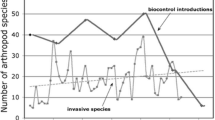Overview
- Editors:
-
-
R. L. Ridgway
-
U.S. Department of Agriculture, Beltsville, USA
-
S. B. Vinson
-
Texas A & M University, College Station, USA
Access this book
Other ways to access
About this book
The protection of agricultural crops, forest, and man and his domestic animals from annoyance and damage by various kinds of pests remains a chronic problem. As we endeavor to improve pro duction processes and to develop more effective and acceptable tactics for achieving this protection, we must give high priority to all potentially useful techniques for the control and management of insects. Pest control is recognized as an acceptable and necessary part of modern agriculture. Methods employed vary greatly and tend to reflect compromises involving 3 determining factors: technological capability, economic feasibility, and social acceptability. How ever, these factors are also subject to change with time since each involves value judgments that are based on available information, cost, benefit considerations, the seriousness of the pest problem, and the political climate. Whatever method is chosen, energy resources continue to dwindle under the impact of increasing popu lation, and it is inevitable that greater reliance must be placed upon renewable resources in pest management. One alternative is the use of a pest management method that uses the energy of the pest's own biomass to fuel a self-perpetuating control system. The use of biological control agents for the control of pests has long been an integral part of the pest management strategy in crop production and forestry and in the protection of man and animals. The importance and unique advantages of the method are well recognized; numerous treatises deal with accomplishments and methodologies.
Similar content being viewed by others
Table of contents (15 chapters)
-
Back Matter
Pages 451-480
Editors and Affiliations
-
U.S. Department of Agriculture, Beltsville, USA
R. L. Ridgway
-
Texas A & M University, College Station, USA
S. B. Vinson




